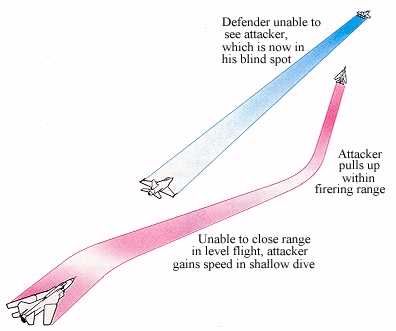Low Speed Yoyo
Low Speed Yoyo
 Another combat situation which can arise is a stalemate in either
a tail chase or turning match. To break the stalemate, a low-speed yoyo
is used. This is based on the age-old concept of trading height for
speed. If the pursuer finds that he is unable to close to within shooting
range in straight flight, he can gain extra speed in a shallow dive. This
will allow him to close the horizontal distance and takes him into his
opponent's blind spot at six o'clock low. When a suitable position and
overtaking
speed can be attained, the pursuer can pull up and attack. The counter?
Keep a good lookout behind!
More often, the low-speed yoyo is uded to break a stalemate in a
turning fight. Tha attacker drops his nose to the inside od the turn,
then cuts low across the circle before pulling up towards his opponent's
six o'clock. The gain is often marginal, but repeating the process
nibbles off a few degrees of angle each time, due to maneuvreing in the
vertical plane. The pull-up should be started when a position of about 30
degrees angle-off is reached. It is important that the angle of cut-off
is correct or the attacker will arrive in a fly-through situation with
too much angle-off as he approaches the targetr. If this happens then he
must endeavour to pull up into a high-speed yoyo.
Defence against the low-speed yoyo takes two forms. The first is
to copy the maneuvre while remainingin phase with the attacker. This
maintains the stalemate. The secound counter is more psitive, The
defendeing turn into his opponent.
If the attacking pilot has tried to lead the defender by too much
or dived too low by being greedy, the defender can also pull up and
barrel down onto the attacker.
Another combat situation which can arise is a stalemate in either
a tail chase or turning match. To break the stalemate, a low-speed yoyo
is used. This is based on the age-old concept of trading height for
speed. If the pursuer finds that he is unable to close to within shooting
range in straight flight, he can gain extra speed in a shallow dive. This
will allow him to close the horizontal distance and takes him into his
opponent's blind spot at six o'clock low. When a suitable position and
overtaking
speed can be attained, the pursuer can pull up and attack. The counter?
Keep a good lookout behind!
More often, the low-speed yoyo is uded to break a stalemate in a
turning fight. Tha attacker drops his nose to the inside od the turn,
then cuts low across the circle before pulling up towards his opponent's
six o'clock. The gain is often marginal, but repeating the process
nibbles off a few degrees of angle each time, due to maneuvreing in the
vertical plane. The pull-up should be started when a position of about 30
degrees angle-off is reached. It is important that the angle of cut-off
is correct or the attacker will arrive in a fly-through situation with
too much angle-off as he approaches the targetr. If this happens then he
must endeavour to pull up into a high-speed yoyo.
Defence against the low-speed yoyo takes two forms. The first is
to copy the maneuvre while remainingin phase with the attacker. This
maintains the stalemate. The secound counter is more psitive, The
defendeing turn into his opponent.
If the attacking pilot has tried to lead the defender by too much
or dived too low by being greedy, the defender can also pull up and
barrel down onto the attacker.
Other pages I've made
My main page
Aircraft pages
Main Maneuvres page
Pairs Maneuvres page
The Break
The Scissors
The High G Barrel Roll
Jinking
The Spiral Dive
The Vertical Rolling Scissors
The Slpit S
The High-Speed Yoyo
The Rollaway
Lag Pursuit
The Barrel Roll Attack
Some Skills needed for Air Combat Pilots

